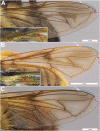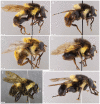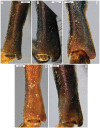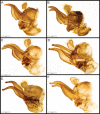Taxonomic revision of Romaleosyrphus Bigot (Diptera, Syrphidae), including descriptions of seven new species
- PMID: 35046750
- PMCID: PMC8671705
- DOI: 10.3897/zookeys.1075.55862
Taxonomic revision of Romaleosyrphus Bigot (Diptera, Syrphidae), including descriptions of seven new species
Abstract
The genus Romaleosyrphus Bigot is reviewed, including the description of seven new species (R.argosi Moran, sp. nov., R.bigoti Moran, sp. nov., R.drysus Moran, sp. nov., R.nephelaeus Moran & Thompson, sp. nov., R.soletluna Moran & Thompson, sp. nov., R.vockerothi Moran & Thompson, sp. nov. and R.woodi Moran, sp. nov.). Romaleosyrphusarctophiloides (Giglio-Tos), comb. nov. is transferred to Romaleosyrphus. Romaleosyrphus stat. rev. is redefined to represent the monophyletic unit of species within Criorhinina which possess holoptic males, a proximal ventral half of vein C with setae, a broad intersection of vein R1 with vein C, the distal part of R4+5 beyond M1 longer than cross-vein h and appressed pile on the abdomen. Descriptions, habitus and genitalia photographs, distributions, and an illustrated key for all nine Romaleosyrphus are presented. DNA barcode data are provided for eight of the species with a cytochrome c oxidase subunit I gene tree presented and discussed.
Keywords: Criorhinina; Eristalinae; flower fly; hoverfly; identification key; taxonomy.
Figures












References
-
- Aldrich JM. (1905) A catalogue of North American Diptera (or two-winged flies) VL – XLVI. Smithsonian Miscellaneous Collections 46 (2): I–680. 10.5962/bhl.title.1681 - DOI
-
- Bigot JMF. (1882a) Descriptions de genres et espèces inédits de Syrphidés (3eme partie). Bulletin de la Société Entomologique de France 14: 159–163. https://biodiversitylibrary.org/page/4241989
-
- Bigot JMF. (1882b) Diagnoses de genres et espèces inédits de Syrphidés. 3eme partie. Annales de la Société entomologique de France (6)2: 128–129. https://biodiversitylibrary.org/page/8998058
-
- Bigot JMF. (1883) Diptères nouveaux ou peu connus. 21e partie, XXXII: Syrphidi (1ere partie). Annales de la Société entomologique de France (6) 3: 221–258. [1883.10.31] https://biodiversitylibrary.org/page/32548784
-
- Bruijnzeel LA, Scatena FN, Hamilton L. (2010) Tropical Montane Cloud Forests: Science for Conservation and Management. Cambridge University Press, 768 pp. 10.1017/CBO9780511778384 - DOI
LinkOut - more resources
Full Text Sources
